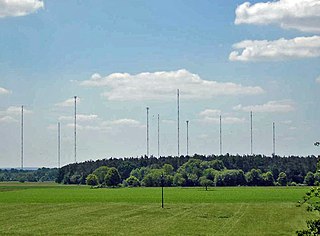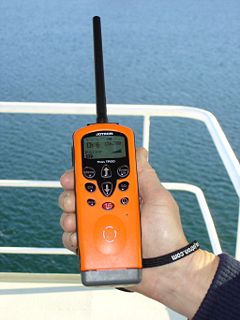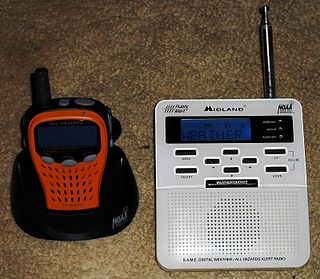
In radio, longwave, long wave or long-wave, and commonly abbreviated LW, refers to parts of the radio spectrum with wavelengths longer than what was originally called the medium-wave broadcasting band. The term is historic, dating from the early 20th century, when the radio spectrum was considered to consist of longwave (LW), medium-wave (MW), and short-wave (SW) radio bands. Most modern radio systems and devices use wavelengths which would then have been considered 'ultra-short'.
Specific Area Message Encoding (SAME) is the protocol used to encode the Emergency Alert System (EAS) and NOAA Weather Radio (NWR) in the U.S. and Weatheradio Canada in Canada. It is also used to set off receivers in Mexico City and surrounding areas as part of the Mexican Seismic Alert System (SASMEX).

NOAA Weather Radio is an automated 24-hour network of VHF FM weather radio stations in the United States that broadcast weather information directly from a nearby National Weather Service office. The routine programming cycle includes local or regional weather forecasts, synopsis, climate summaries, synopsis or zone/lake/coastal waters forecasts. During severe conditions the cycle is shortened into: hazardous weather outlooks, short-term forecasts, special weather statements or tropical weather summaries. It occasionally broadcasts other non-weather related events such as national security statements, natural disaster information, environmental and public safety statements sourced from the Federal Communications Commission's (FCC) Emergency Alert System. NOAA Weather Radio uses automated broadcast technology that allows for the recycling of segments featured in one broadcast cycle seamlessly into another and more regular updating of segments to each of the transmitters. It also speeds up the warning transmitting process.

WWV is a shortwave radio station, located near Fort Collins, Colorado. It is best known for its continuous time signal broadcasts begun in 1945, and is also used to establish official United States government frequency standards, with transmitters operating on 2.5, 5, 10, 15, and 20 MHz. WWV is operated by U.S. National Institute of Standards and Technology (NIST), under the oversight of its Time and Frequency Division, which is part of NIST's Physical Measurement Laboratory based in Gaithersburg, Maryland.

DCF77 is a German longwave time signal and standard-frequency radio station. It started service as a standard-frequency station on 1 January 1959. In June 1973 date and time information was added. Its primary and backup transmitter are located at 50°0′56″N9°00′39″E in Mainflingen, about 25 km south-east of Frankfurt am Main, Germany. The transmitter generates a nominal power of 50 kW, of which about 30 to 35 kW can be radiated via a T-antenna.

Marine VHF radio refers to the radio frequency range between 156 and 174 MHz, inclusive. The "VHF" signifies the very high frequency of the range. In the official language of the International Telecommunication Union the band is called the VHF maritime mobile band. In some countries additional channels are used, such as the L and F channels for leisure and fishing vessels in the Nordic countries.
The Global Maritime Distress and Safety System (GMDSS) is an internationally agreed-upon set of safety procedures, types of equipment, and communication protocols used to increase safety and make it easier to rescue distressed ships, boats and aircraft.

Digital selective calling or DSC is a standard for transmitting pre-defined digital messages via the medium-frequency (MF), high-frequency (HF) and very-high-frequency (VHF) maritime radio systems. It is a core part of the Global Maritime Distress Safety System (GMDSS).

Radiofax, also known as weatherfax and HF fax, is an analogue mode for transmitting monochrome images. It was the predecessor to slow-scan television (SSTV). Prior to the advent of the commercial telephone line "fax" machine, it was known, more traditionally, by the term "radiofacsimile". The cover of the regular NOAA publication on frequencies and schedules states "Worldwide Marine Radiofacsimile Broadcast Schedules".
The radio frequency of 500 kilohertz (500 kHz) has been an international calling and distress frequency for Morse code maritime communication since early in the 20th century. The unit kilohertz was not introduced until the 1960s. For most of its history, the international distress frequency was referred to by its equivalent wavelength, 600 meters, or, using the earlier frequency unit name, 500 kilocycles or 500 kc.

The automatic identification system (AIS) is an automatic tracking system that uses transponders on ships and is used by vessel traffic services (VTS). When satellites are used to detect AIS signatures, the term Satellite-AIS (S-AIS) is used. AIS information supplements marine radar, which continues to be the primary method of collision avoidance for water transport.

A weather radio is a specialized radio receiver that is designed to receive a public broadcast service, typically from government-owned radio stations, dedicated to airing weather reports on a continual basis, with the routine weather reports being interrupted by emergency weather reports whenever needed. Weather radios are typically equipped with a standby alerting function—if the radio is muted or tuned to another band and a severe weather bulletin is transmitted, it can automatically sound an alarm and/or switch to a pre-tuned weather channel for emergency weather information.
The radio frequency 2182 kHz is one of the international calling and distress frequencies for maritime radiocommunication in a frequency band allocated to the mobile service on primary basis, exclusively for distress and calling operations.
Weatheradio Canada is a Canadian weather radio network that is owned and operated by Environment and Climate Change Canada's Meteorological Service of Canada division. The network transmits in both official languages from 230 sites across Canada. Weatheradio Canada like their telephone service, uses the Starcaster Text to Speech, which has been used for many years and is owned by STR-SpeechTech Ltd.
This is a list of the acronyms and abbreviations used in avionics.

NAA was a major radio facility, located in Arlington, Virginia from 1913 until 1941 and operated by the United States Navy. The station was originally constructed as the first link in a network of high-powered transmitters used for international communication. During its years of operation NAA was best known for broadcasting daily time signals, however, it also provided a variety of additional services, using multiple transmitters operating on frequencies ranging from longwave to shortwave. The station also conducted extensive experimental work, including, in 1915, the first transatlantic transmission of speech.
















